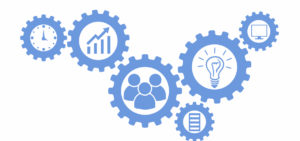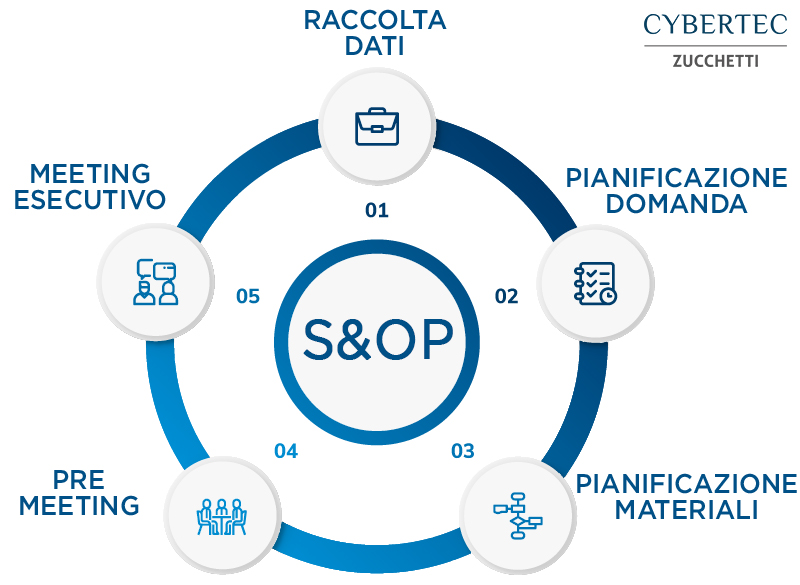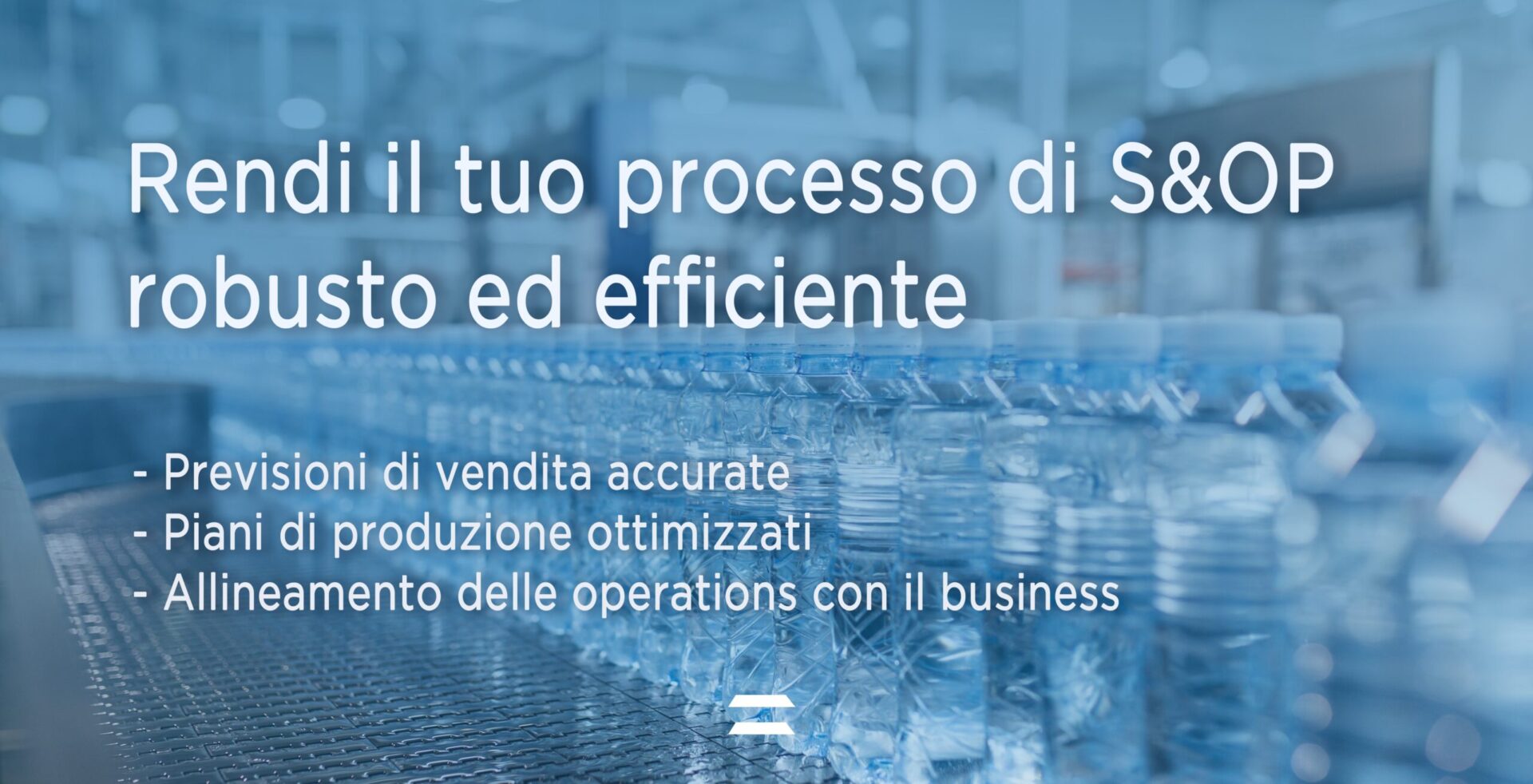S&OP (Sales and Operations Planning) processes are carried out by companies to align demand, supply and finance with company objectives. The purpose of the S&OP processes is therefore to provide company management with an indication of the real performance of operations with respect to financial planning, to guide them in an effective management of the company supply chain that avoids incorrect choices that could compromise overall efficiency. It is therefore intended to align in a single program objectives and strategies from the apparently antithetical worlds of supply and demand.
The main obstacles of the S&OP process and how to overcome them
There are three equally important pillars critical to success in today’s world:
- people;
- processes;
- technology.
These three pillars are equally important, and it is difficult to succeed in today’s competitive world without analyzing the sum of these three variables. However, in an increasingly fast-paced world, processes can change a lot depending on the technology that supports them. At the same time, people can emphasize their knowledge and make the best decisions when supported by powerful tools. So what are the enabling technologies to compete in today’s market and even more so in the near future? Which ones allow you to emphasize human capabilities, designing advanced processes?

The S&OP Cycle
Product review: In this first phase, planners involved in research and development, product development, and new product introduction analyze the health status of products on the market, examine product pipelines, and come to decisions about product planning. These decisions could include setting start dates for new productions or prioritizing activities and allocating resources. Another topic discussed at this stage may be the one also known as cannibalization or suppression or the impact on existing products following the introduction of a new product.
Demand review
: The objective of this phase is an unconstrained forecast or consensual demand planning, incorporating a holistic picture of independent and dependent demand.
Factors influencing independent and dependent demand may include marketing activities, new product introduction, consumer trends, product hierarchy, and demand for parts between plants. The consensual demand plan is based on a combination of sales, marketing and product plans. The demand plan is measured in units or revenue. Statistical forecasting is combined with customer input and marketing plans to estimate, refine, and arrive at a consensus plan. Historical performance will be taken into account in the plan and at the end the demand plan will be compared with the results of the financial review to identify any revenue or demand gaps.
Supply Review
: The objective of this phase is a supply plan that synchronizes with the demand plan.
Ideally, these two floors work in unison. The procurement plan should balance customer service and minimize inventory and operating costs. A basic production plan and an approximate capacity plan are developed, along with alternative supply plans that take into account changes in capacity and demand. “What-if” scenarios play a key role at this stage of the process, so it is essential to have a technology platform that has the ability to perform these calculations using real-time data. These scenarios vary from more tactical “what-if” questions to longer-term scenarios, but the function of both is the same: to reduce risk and understand the positive and negative aspects of a wide range of adjustments. Examples of simpler scenarios include rebalancing inventories or the workforce, and more complex scenarios such as onboarding a new supplier, a new capability, or training the workforce. Ideally, as these scenarios develop, they are automatically linked to budgetary needs so financial risk projections can be made.
Financial review
: the position of this phase within the process is debated.
Some insist that it should be placed after the first three stages have been completed, others say it should be “always on.” In any case, the mission remains the same: to produce a set of baselines that then become adjustments to the product, demand, and supply review, along with the inputs used in previous S&OP and executive S&OP reviews. At this stage, the previous month’s financial performance is consolidated to provide input for the analysis of the current month’s S&OP cycle. Finance controls this process and can include different categories or viewpoints, including product, geography, customer, and channel. Actual costs are compared to budgets and forecasts to analyze the accuracy of forecasts over a continuous period of time. A S&OP connected approach means that, regardless of where this phase of the process falls, financial analysis plays a key role in producing pre-S&OP input and regarding executive S&OP.
Pre-S&OP: The Pre-S&OP is a series of meetings conducted with leaders at various levels that show the connectivity of plans between product, demand, supply and finance. Ideally, these meetings are centered around a cloud-based platform that hosts all plans in one place. The purpose of pre-S&OP is to identify major gaps and disconnections and create strategies to manage these issues. Plans are reviewed in shared dashboards and variance is analyzed against actual variance, keeping in mind objectives and budgets. Metrics such as revenue, profit, and inventory are analyzed at both the enterprise and product line levels to gain an understanding of the financial and operational implications of decisions. Adjustments to product, demand and supply plans are made in real time.
Executive S&OP
: The final S&OP phase brings all plans and data together in a single cloud-based platform for use in executive S&OP meetings.
What-if scenarios and associated risks are reviewed and decision points are noted so that leadership knows when appropriate choices will need to be made. All key decisions that have not been resolved in the first five phases are addressed in this phase, the reasons for the escalation are examined, and deadlines for decisions are set.
Decisions made at this stage can have far-reaching implications across the company, so when using the right technology platform, the impacts of those decisions can be analyzed and applied to key metrics in real time. In the end, the goal of the executive S&OP is to generate an aggregated final plan that is sent to cross-functional owners and distributed downstream in all affected areas.

Technologies that make a difference in the S&OP process
The main tools currently used within companies are ERPs together with Excel files.
The first, or Enterprise Requirements Planning, are powerful data collection tools, which unfortunately fail to process data effectively to the point of providing very dynamic scenarios. For this reason, this software is accompanied by dozens (but sometimes even hundreds) of Excel and Project files. The latter, born in the 1970s, create information silos within the company by blocking an otherwise virtuous flow of supply chain information.
These tools can no longer support high-volume companies and mix to optimize production, manage reliable forecasts and maintain focus on business objectives. This is why more and more companies are equipping themselves with specific tools for the optimal management of the S&OP process.
These tools are the APS (Advanced Planning and Scheduling systems) that extend the planning capabilities of the ERP, to which they connect, eliminating Excels and managing all the processes involved in the S&OP in a single tool. The APS add capabilities for effective demand forecasting, finite capacity planning, detailed scheduling, purchase planning and interactive what-if analysis. In addition, they allow an early and more effective identification of problems thanks to extensive graphical representations, allowing you to evaluate the plan with KPIs before it is implemented. The main impacts of these S&OP solutions are:
- Increased visibility into company production processes;
- Increase in the speed of processing production plans;
- Interactivity;
- Collaboration between company personnel from different departments.
These capabilities are enabled by some important features of APS software, such as:
- The collaborative platform;
- Powerful algorithms capable of quickly managing the information contained in the data;
- Rapid interaction with the user;
- The alignment of sales forecasts with the production plan and its constraints;
- The planning of resources on various levels, going down to the detailed scheduling.
All these skills lead to very important benefits such as:
- Increase in the level of service;
- Reduction of warehouses;
- Reliable sales forecasts;
- Increased internal communication;
- Optimal use of production capacity;
- Cost containment;
- Increased visibility on the Supply Chain;
- Risk reduction.
But not all APS are the same
However, not all technologies can provide the same benefits. This is also true for APS. What are the 7 characteristics to evaluate when making a software selection of an APS?
- Interface – many software tend to follow the idea of automation, completely eliminating the human-machine iteration which, however, remains and will remain fundamental for a long time;
- Graphics – allows you to maximize the benefits of interactivity by immediately highlighting critical points;
- Speed – to make the iterative cycle effective and efficient;
- Finite capacity – not only of resources but also of materials to calculate really feasible plans;
- Customisable – designed to meet the specific needs of manufacturing companies;
- Adaptability – to every process, need and company;
- Integrability and data ownership – the software must be easily and securely integrable so as to centralize and share information while ensuring data ownership.
CyberPlan is the Advanced Planning and Scheduling software that has all these fundamental characteristics for the S&OP process. This S&OP software has been developed for manufacturing companies and adapted to all types of companies, being used successfully both in small-medium companies such as the typical Italian company, and in multinationals belonging to the well-known “Fortune 500” ranking. Today in these companies the collaboration has brought greater trust and participation by the sales departments towards the demand forecasting process. In these companies, less time is now spent discussing and there is instead a greater control of sales and production forecasts. CyberPlan is also officially certified as DDMRP (Demand Driven MRP) by the Demand Driven Institute.
Request a free demo >
See for yourself how CyberPlan can help you improve the performance of your Supply Chain.

